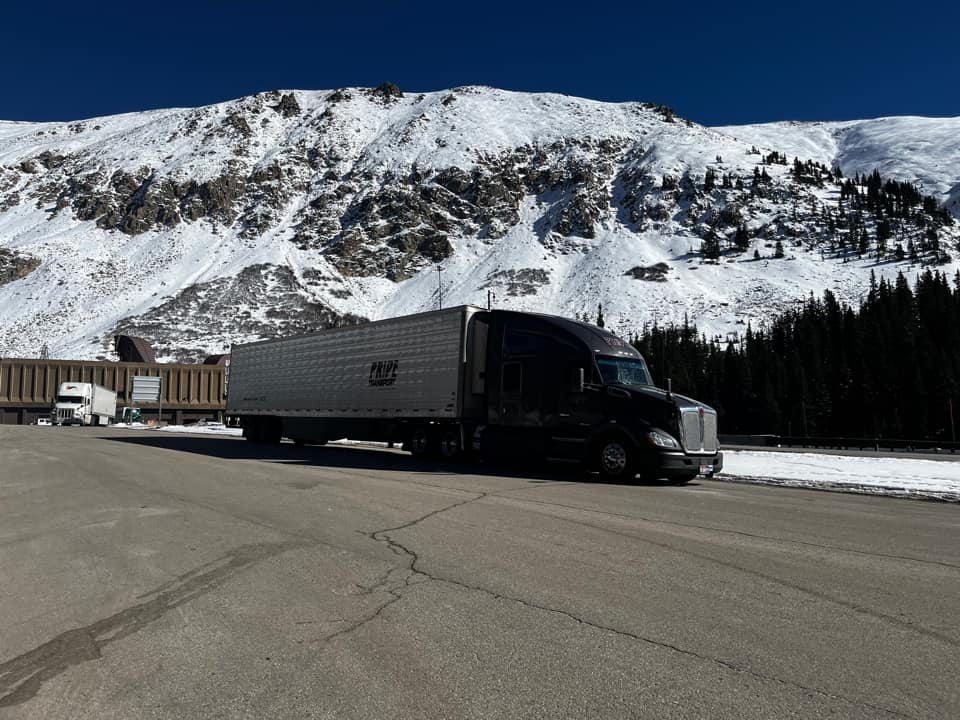by Pride Transport | Dec 05, 2022
There’s a lot to be aware of anytime you’re operating a truck, even under perfect driving conditions. But when bad weather hits, truck drivers need to be ready with another set of safe-driving skills.
Statistics show that of the 5.89 million vehicle crashes each year, approximately 20% are related to inclement weather conditions. This shows that even the most skilled drivers can have a tough time driving in bad conditions, especially when you can’t control how other people will handle the road when the weather shifts. Be prepared by knowing what to watch for and taking precautions now.
Common Hazards and How to Handle Them
Bad weather comes in many different forms. Rain, snow, sleet, and even windy conditions can throw you for a loop if you can’t anticipate how they’ll affect your driving. Here are a few weather-related hazards to keep in mind the next time the skies look gray.
Decreased visibility
When driving a vehicle that weighs 20 to 30 times more than the average car, visibility is extremely important. Rain, fog, snow, and smoky conditions can make it harder to see the road, and the time of day when these conditions hit can create an even bigger challenge. Check that the headlights and hazards work, and be sure that your truck is equipped with good windshield wiper blades and the proper wiper fluid before beginning your drive.
(Bonus tip: In snowy daytime conditions, sunglasses can help to cut the glare from the sun on the snow and make it easier to see.)
Wet roads
Wet pavement is a factor in 70% of vehicle crashes, so be prepared to slow down on wet or slick roads. Trucks already require more space than passenger vehicles to safely stop; that necessary distance increases significantly when precipitation hits. Take note of your surroundings and adjust the traveling distance between your truck and the vehicle in front of you.
Flying and/or loose objects
Wind can do a lot of damage on its own. When the winds whip up, prepare to steer with caution to minimize sway into other traffic lanes. Stay alert in high-traffic areas where flying or loose objects could distract you or other drivers.
If something does hit your windshield hard enough to do damage, pull over at the next safe location — ideally a designated rest stop so that you can safely exit the vehicle — to properly assess the damage.
Cars stopped on the side of the road
Other drivers might run into problems in bad weather that require them to pull over. If possible, attempt to maneuver at least one lane away from any pulled-over vehicle that has hazards or other emergency lights flashing. (In some states, like Ohio, this is the law). Awareness is key to keeping everyone safe.
How to Prepare for Bad Weather
Nobody wants to scramble for solutions when they’re in the middle of less-than-ideal conditions. Take these precautions before heading out.
Check the weather
It might seem obvious, but it’s worth repeating: check the weather forecast before beginning your drive. This is especially important when driving in areas with notoriously fickle weather patterns or regions that are new to you. Reference more than one reliable source to be extra sure that you know what to expect. AccuWeather and WeatherBug are reliable mobile app options.
Have a back-up plan for communicating
Most people travel with mobile phones, but your radio is just as important in inclement weather. Cell phone coverage isn’t always reliable, and bad weather can make weak connections non-existent. Keep your radio ready for updates, severe weather warnings, and instructions from your dispatcher/controller.
Drive with caution and stop if necessary
Careful driving is always important, but bad weather requires heightened awareness and extra caution. Stay aware of your surroundings and know when it’s safe to pull over. Even if you just need a few minutes to let the weather pass, it’s better to take that moment than to press on and risk putting yourself or others in danger. When stopped, put on your hazards and remain in your vehicle.
Remain calm
Taking the right precautions should minimize any reason for panic. Still, it’s good to have a few tricks to help keep calm in tense situations.
If you’re really unsure of your safety or ability to safely operate the vehicle, pull over.
Take several deep breaths, slowly exhaling after every inhale. Check in with your dispatcher and check a radar if possible. If the weather looks like it will stick around for a while, call a friend or family member to help keep you calm while waiting out the storm.

Prepping Your Vehicle
You don’t have to wait for bad weather before prepping your truck — in fact, you shouldn’t wait! Stay up-to-date on vehicle inspections and always complete a pre-trip inspection before you drive. Drivers should take these measures before every trip, but it’s especially worth it to take the time to check your vehicle when bad weather is in the forecast.
Stowing emergency equipment in your cab helps to ensure you can handle bad weather scenarios, too. Some items to always have on hand (without taking up too much space) include:
- Salt or sand
- Shovel
- Rain poncho
- Safety cones/flares
- Non-perishable snacks
- Phone charger/battery
- Flashlight
- Battery-powered radio
- First-aid kit
These items, along with any emergency supplies provided by your company, can go a long way in keeping you safe and offering peace of mind in any driving conditions.
Your maintenance crew plays a big role in on-road safety, too. Learning about the repairs and preventative maintenance they complete on the vehicles will not only make you a better, more prepared driver, but this knowledge can also help keep you calm in adverse weather conditions. Make sure you understand the braking system, electrical system, and the tire conditions on your vehicle.
We can’t control the weather, but we can control how we respond to it, and that starts with training safe drivers. Driver safety is our top priority at Pride Transport. Learn more about our commitment to safety and see if one of our driver opportunities is right for you.
